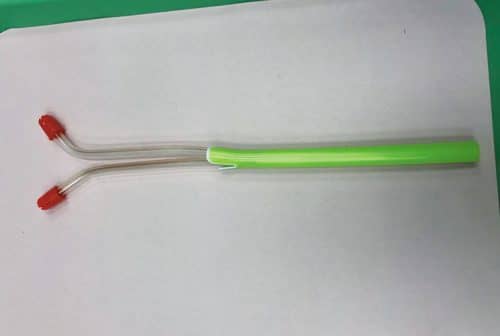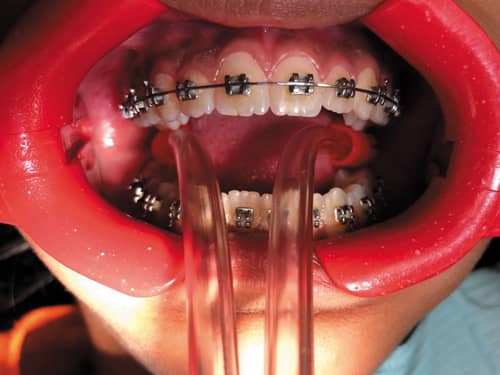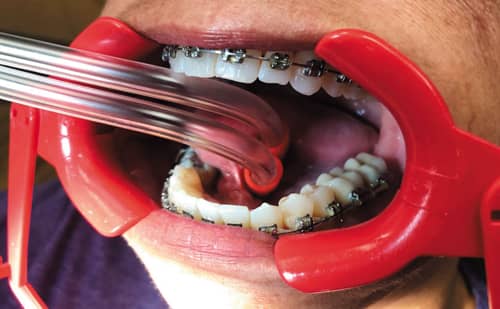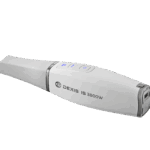Dry field isolation can be difficult when bonding orthodontic appliances, especially with regard to second molars. More often than not, bonding second molars must be done one side at a time to prevent excessive salivary flow, and stretching the buccal mucosa can often be uncomfortable to the patient. The following is an easy technique our practice, Dr Melanie Orthodontics, uses to isolate left and right sides at the same time, thus shortening the appointment time and making it a comfortable experience for the patient.

Technique
This procedure is demonstrated on a 13-year-old female ready to have maxillary and mandibular second molars bonded. Dri-angles and a NOLA lip retractor are first placed on patient. Two saliva ejectors are placed into a high-volume evacuation (HVE) tip (Figure 1). (This is not always easy; they may need to be strong-armed into the HVE tip.) The ends of the saliva ejector tips are turned bucally and the patient is asked to bite down on them (Figure 2). Having the saliva ejectors enter the mouth at the anteriors and turning the tips out helps maintain an unruly tongue. A variation of this would have the saliva ejectors placed along the occlusal edges, with the tips end distal to the second molars. For stability, it can also be helpful to have the patient hold the HVE handle.

Discussion
This technique has helped our office expedite repositioning appointments in which only bonding second molars is required. However, it is also feasible to bond more if isolation is spectacular. Typically, our repositioning appointments are blocked off for six units, or 1 hour. This includes untying, taking progress records, removing bracket/s, preparing teeth for bonding, bonding, tying in of wires, and scheduling of next appointments. If second molars are the only teeth that require bonding, and no repositioning of other teeth is required, this appointment can take 40 minutes. Using this technique, we have completed the appointment in 30 minutes.

Alternatively, pointing both the saliva ejector heads toward the floor of the mouth and slightly separating them can provide suction and tongue retraction at the same time while assisting with procedures in both orthodontics and general dentistry (Figure 3).
Other keys to successful second molar bonding is to check the occlusion and make sure that the patient isn’t biting directly onto the tube of the bracket. If this is unavoidable, consider bonding bite turbos to the lingual surfaces of the upper central incisors or Bandlok bite mounds to the first molars to prevent the upper molars from biting off the lower molar tubes. Instruct the patient not to eat hard or sticky foods for 24 hours to further maintain bonding integrity. Maintaining a dry field as much as possible will ensure bonding success, especially with the isolation difficulties of second molars. OP
Lona Padua, Orthodontic Assistant, and Melanie Wang, DDS, Dr Melanie Orthodontics, San Diego, Calif.








